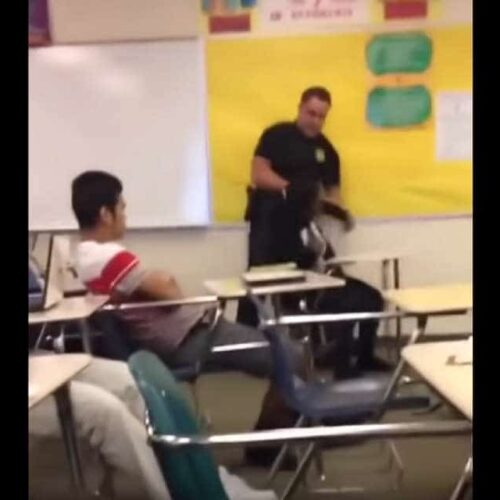Introduction
A coalition of family and civil-rights groups launched a national campaign Wednesday to “end the regular presence” of police, armed security and truancy officers posted inside schools.
The Dignity in Schools coalition took its “Counselors Not Cops” campaign to Washington, D.C. on Wednesday, and held briefings at the U.S. Senate and the House of Representatives.
The harsh disciplinary actions of police assigned to schools, detailed in a series of Center for Public Integrity reports, have become increasingly controversial in recent years, creating worries that criminalization of minor indiscretions has created a counter-productive “school-to-prison pipeline.”
“We decided to take this position as a campaign for full removal of police in schools (because of) the day-to-day experiences of criminalization that have become routine in many schools across the country, and the high-profile incidents that have brought more attention to this issue,” said Dignity in Schools national coordinator Natalie Chap.”
Federal officials have expressed concerns as well, but have stopped short of calling for removal of cops entirely. This month, the U.S. Department of Education and the Department of Justice released a set of “tools” for school districts to “responsibly incorporate” officers into the learning environment.
In 2014, the departments released a volume of recommended discipline practices to help schools move away from suspensions that were robbing large numbers of kids of class time. Officials have urged schools to limit the use of school police because of the negative impact on students who are handcuffed and sent into courts for common adolescent—or even prepubescent—behaviors that might better be handled by teachers, counselors and parents.
“I am concerned about the potential for violations of students’ civil rights and unnecessary and harmful introduction of children and young adults into a school-to-prison pipeline,” U.S. Department of Education Secretary John B. King also wrote in a letter this month to school districts about the issue.
Since 2012, investigations by the Center for Public Integrity have shown that arrests, ticketing and rough physical contact fall most heavily on student with disabilities and students of color. National data from 2011-2012 pointed to Virginia’s rates for police-student contact as the highest in the country; local police data showed that thousands of black children, many in middle school, were arrested for disorderly conduct in disproportionate numbers. An autistic 11-year-old sixth grader, for example, was charged with disorderly conduct for kicking a trash can and felony assault for trying to wiggle free from an officer.
In California, juvenile court judges have objected to Los Angeles school police sending thousands of middle-school children—almost all Latino or black—into courts with citations for disturbing the peace. First graders were cited for fighting, 10-year-olds for trespassing; students arriving minutes late were caught in police sweeps that charged them with daytime curfew violations in low-income neighborhoods. In San Bernardino, California, a student with Down syndrome was hogtied and arrested and a boy who hugged his girlfriend was sprayed with pepper spray and charged with assaulting a school officer. The charges were later dismissed against the student, who dropped out of high school.
At the U.S. Senate briefing on Wednesday, Tanya Clay House, a deputy assistant secretary for the U.S. Department of Education, addressed Dignity in Schools affiliates. “Secretary King and the Department of Education hear you,” House said, “and we really respect the work you’re doing.”
Dignity in Schools, which operates in 27 states, has more than 100 city and state member groups, among them the NAACP Legal Defense and Educational Fund.
House agreed with Dignity in Schools affiliates that schools are sorely lacking counselors and other adult support at schools to help them with problems and tension at school.
“We know, right now, that 1.6 million schoolchildren have a school resource officer, but no counselor,” House said.
In response to concerns about crime or school shootings, many school districts nationwide have added school resource officers, and a number of large districts have developed their own school police forces.
“We understand there are may be rare occasions when it might be appropriate for law enforcement to enter a school building,” Chap said. “But we want to make sure there are agreements in place with police departments that limit the cases where law enforcement can be called in.”
If police go into schools, Chap said, officers and educators should have clear agreements in place that restrict the role of police, protect students’ due process rights and ensure that officers aren’t getting involved in disciplinary matters. Chap said her members can provide examples of reforms in their schools proving that conditions in schools can get better with the use of counselors and trained behavior intervention staff to support students.
“We want to create safe schools,” she said, “with positive safety and discipline measures.”
Read more in Education
Criminalizing Kids
When schools call police on kids
Schools refer tens of thousands of students to law enforcement every year. Black children and students with disabilities get the brunt of it.
Criminalizing Kids
Our reports show why school police are under fire after Floyd protests
Districts removing cops or considering it after Black Lives Matter marches


Join the conversation
Show Comments